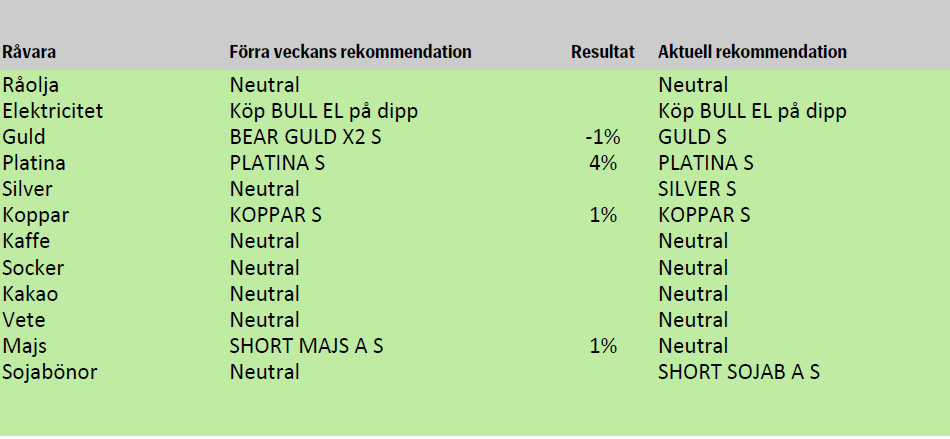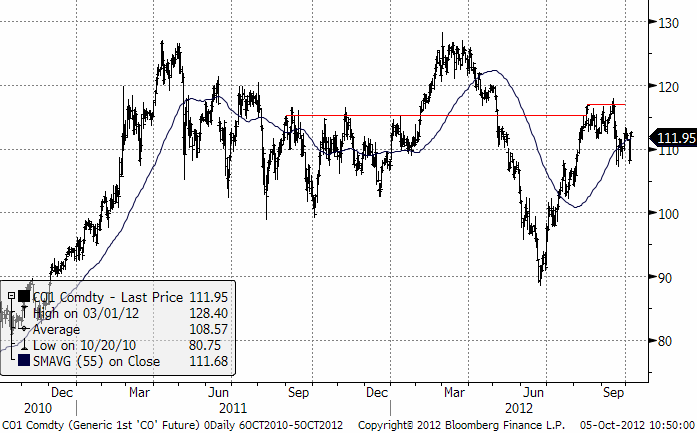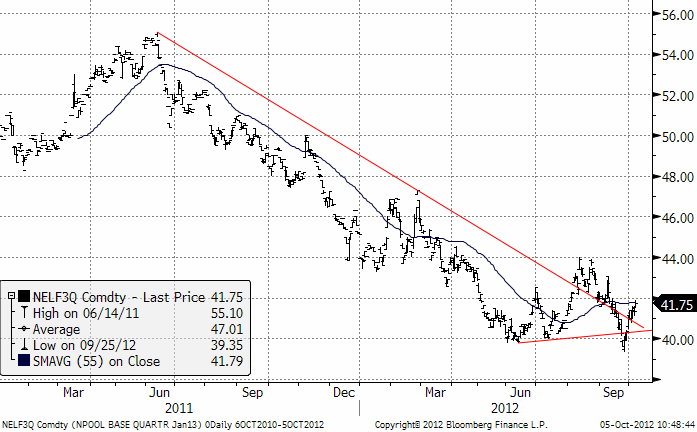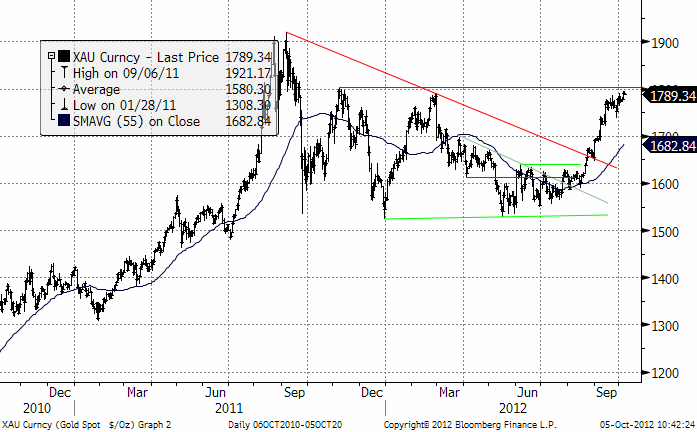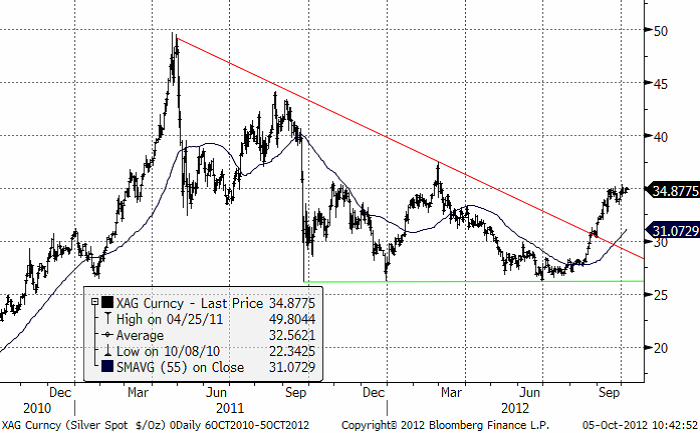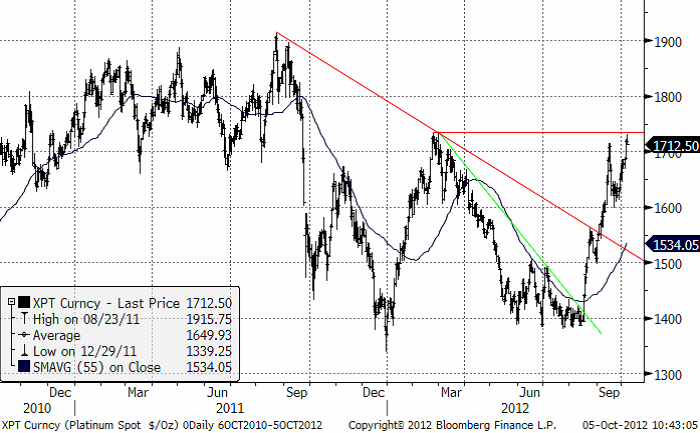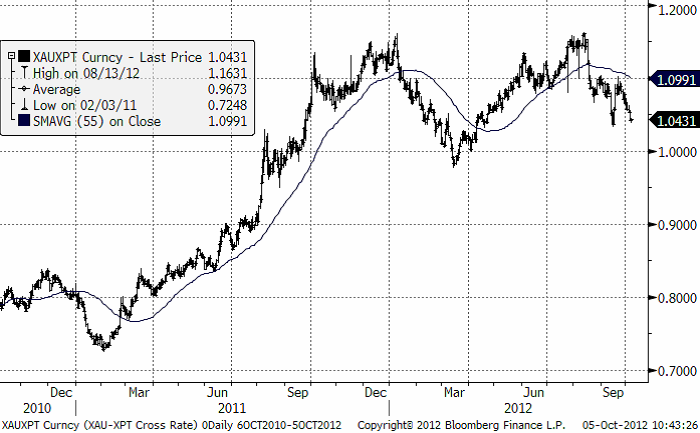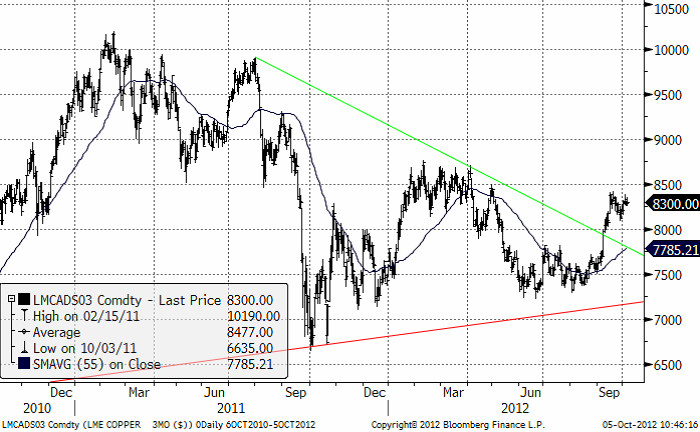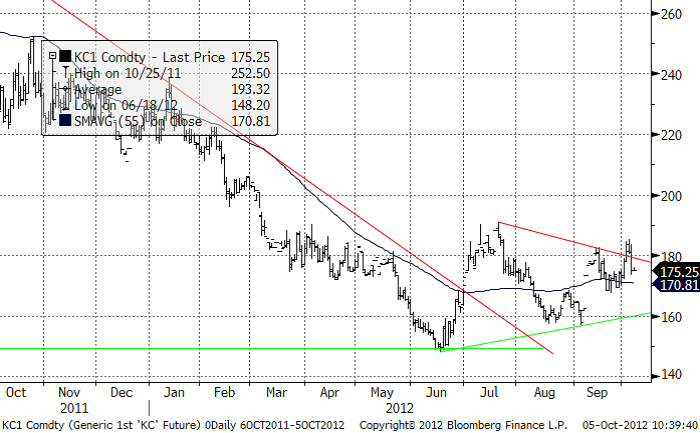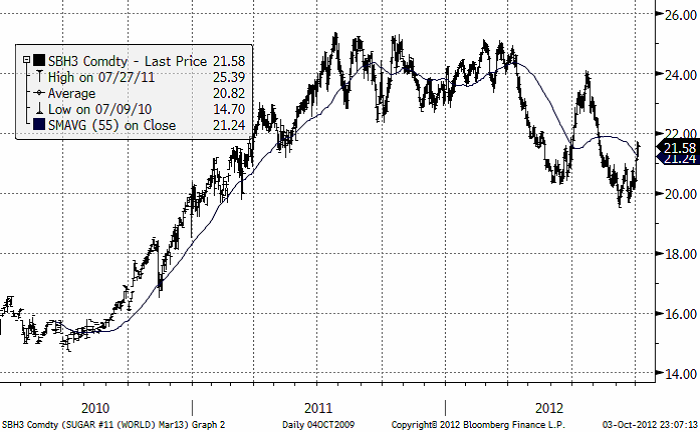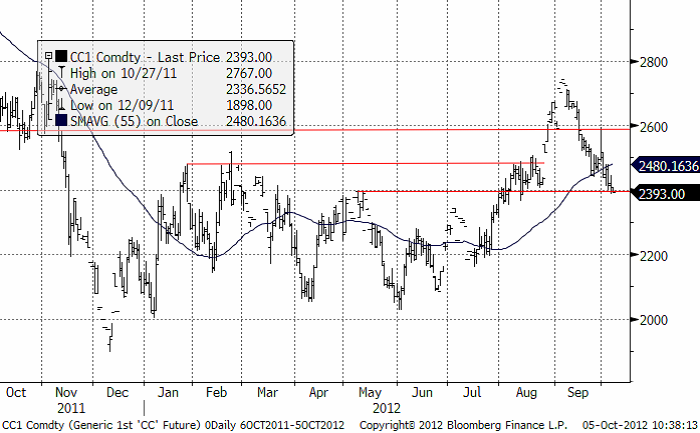Analys
SEB – Råvarukommentarer, 5 oktober 2012
Sammanfattning av rekommendationer
Förra veckans rekommendationer gav en samlad vinst på 5%. Vi stänger den korta positionen i majs. Vi väljer att gå kort. Sojabönor, som dock ligger på tekniskt stöd nu och som man hellre bör sälja på rekyler uppåt. Vi stänger förra veckans mycket kortsiktiga kontra-trend-rekommendationen i guld, som visade sig vara fel. Platina fortsätter att vara vår huvudfavorit.
Råolja – Brent
Råoljemarknaden har var under press i veckan och Brent var på onsdagen ned hela 3%. Flera olika faktorer har bidragit till pressen ned. Marknaden har tidigare varit mer fokuserad på störningar på utbudssidan och på den geopolitiska oron i Mellanöstern. Tecken på vikande aktivitet i Kina har, tidigare, inte påverkat priset på olja på samma sätt som t e x metaller. Nu verkar det ändå skett ett skifte där man prisar in efterfrågefaktorer mer. Tecken finns bland annat på att sanktionerna mot Iran börjar ge resultat (se nedan). Dessutom redovisas högre produktion från bland annat Ryssland, Irak och också från USA, som nu är uppe på den högsta produktionsnivån sedan 1996! med 6.52 miljoner fat/dag.
Flera faktorer på utbudssidan har mildrats; Det verkar som sanktionerna mot Iran börjar ge resultat. Regimen pressas sedan tidigare av uteblivna intäkter från oljeexport. I september exporterades 1.15 miljoner fat/dag jämfört med 2.4 miljoner fat/dag i genomsnitt förra året. Nu har dessutom uppvärmningssäsongen inletts. Iran har, trots att man är stor nettoexportör av råolja, inte tillräcklig raffinaderikapacitet för att förse den inhemska marknaden med oljeprodukter som bensin, diesel och olja för uppvärmning. Istället måste man köpa dessa produkter på den internationella marknaden – till höga priser (bland annat p g a sanktionerna). Att den egna valutan dessutom urholkats i värde gör inte saken bättre. Höga matpriser har redan drivit upp inflationen och nu är situationen än värre. Trycket på regimen är så stort, att chansen för att man återgår till förhandlingar med USA och EU, är bättre än på länge.
I september var rekordstor kapacitet i Nordsjön borta från marknaden p g a underhåll och reparationer. Många av dessa arbeten är försenade men vi räknar ändå med att utbudet snart ökar, vilket bör mildra pressen uppåt på olja. Vi har också passerat den säsongsmässiga toppen på orkansäsongen utan några allvarliga implikationer på oljemarknaden (med undantag för Isaac som kortsiktigt störde produktion och distribution i mexikanska gulfen).
Trots ovanstående argument för nedsidan, så ser vi värde kring Brentpris kring nivåer där priset tidigare vänt åter upp (kring 107-108 usd). Detta då den geopolitiska situationen i Iran och Syrien m fl länder fortsatt verkar för en premie på oljepriset. I skrivande stund handlas kontraktet på 110.20, där vår rekommendation, förblir neutral.
Elektricitet
Elterminerna har rört sig sidledes till svagt upp sedan förra veckan.
I det mesta är situationen oförändrad. Den hydrologiska balansen visar fortsatt på överskott på ca 12-15 TWh och väderprognoserna indikerar mer än normal nederbörd de närmaste 10 dygnen, medan temperaturen indikerar kring normal. Vi är inne i en årstid där normaltemperaturen är fallande men än så länge är det nästan uteslutande regn som fallit.
Vattenmagasinen är mycket välfyllda och kärnkraften har god tillgänglighet med 84% av kapaciteten igång, vilket innebär fortsatt risk för ”körpress” för vattenkraftproducenterna.
Trots det har man lyckat få lite andrum, spotpriset har stigit och spreaden mellan södra Norge och systempris har minskat. Orsaken är bättre kapacitet på kablar för export från Norge samt den säsongsmässiga temperaturminskningen. Vi håller fortsatt en neutral rekommendation men gör oss beredda att köpa.
Guld och silver
Den tekniskt kritiska nivån på nedsidan som vi skrev om förra veckan ($1748) bröts aldrig. Det är först om priset på stängningsbasis ligger under som vi tror att en större rekyl är förestående (som skulle kunna innebära en kortsiktig affärsmöjlighet med en kort position). Som det ser ut just nu strävar istället priset uppåt, och ligger strax ovanför den övre delen av de senaste veckornas konsolideringsintervall, i skrivandes stund handlas $1791. Ligger marknaden kvar på nuvarande nivå eller högre på måndag, så är det en starkare signal eftersom brottet är i riktning med trenden. För den som inte redan köpt, kan det snart vara dags. Timingen är viktig, och den tekniska analysen kan därför vara en värdefull vägledning.
Nedan ser vi kursdiagrammet för guld i dollar per troy ounce.
Nedan ser vi kursdiagrammet för silver i dollar per troy ounce.
Platina
Platina är vinnaren, upp 3,5 % sedan förra fredagen. Som befarat har strejkerna spridits i Sydafrika, nu även till guld- och järnmalmsgruvor. Anglos fyra platinagruvor utanför Rustenburg har drabbats av vilda strejker, och företaget rekommenderar de kvarvarande 20 % av arbetsstyrkan att lämna arbetet då inte säkerheten kan garanteras.
Vi tror på ädelmetaller som placering i nuvarande makromiljö. Den oroliga utvecklingen i Sydafrika har redan påverkat utbudet märkbart. Vi tror att platina priset kommer att utmana igen och återgå till ”normaltillståndet”, d.v.s. att vara dyrare än guld. I skrivandes stund har priset brutit över den tidigare toppen för några veckor sedan på $1715. Nästa tekniska motstånd kommer in vid $1735-nivån. Det ser starkt ut. Trots veckans redan positiva utveckling tror vi inte att det är för sent att köpa.
Nedan ser vi priset på guld dividerat med priset på platina. Vi väntar oss att platina ska fortsätta vinna på guldet.
Koppar
Allmänt om basmetallerna: Månadsskifte innebär inköpschefsindex (ISM), som normalt presenteras den 1:a i månaden för både Europa, USA och Kina. Metallerna korrelerar traditionellt med denna statistik. En siffra över 50 betyder tillväxt och vice versa. Kinas kom in under 50 för andra månaden i rad, men steg från augustis 49,2 till 49,8. USA överraskade med en uppgång från 49,6 till 51,5. Konjunkturen balanserar mellan tillväxt och avmattning. Kina gör vad de kan för att stimulera. Förra veckan gjordes en rekordstor påspädning av likviditet via marknadsoperationer (delvis inför den kinesiska långhelgen i samband med nationaldagsfirandet). Metallpriserna började det nya kvartalet på den positiva sidan.
Koppar och nickel är upp ca 1 % sedan förra fredagen.
Koppar
Vi har i de senaste breven beskrivit kopparmarknaden som i grunden fundamentalt stark. Stimulansåtgärderna borgar för en fortsatt stabil marknad. Det behövs fler indikationer på ökad industriell efterfrågan innan marknaden tar nya tag på uppsidan.
Priset på LME har gjort vissa försök i veckan med en högsta notering på $8380 ( $3,80/Lbs). Men återigen finns inte riktigt kraften. De finansiella aktörerna har redan positionerat sig för uppgång. För nya lyft behöver de fylla på, alternativt att industrin börjar ta en mer framsynt vy och täcker in framtida konsumtion. Kanske avvaktas LME-veckan, då världens metallfolk traditionsenligt samlas i London, i mitten av oktober. Nedan ser vi ett diagram över priset på tremånadersterminen på LME.
Vi väljer att på kort sikt rekommendera en lång position i koppar.
Kaffe
Kaffepriset har fallit tillbaka ner i konsoliderings-zonen. Vi fortsätter att vara neutrala till något positiva till kaffepriset.
Socker
Nedan ser vi priset för leverans i mars nästa år. Trots ett starkt stöd vid 20 cent, ser vi tydligt att den långsiktiga trenden är nedåtriktad.
Kakao
Kakaopriset har nått ett tekniskt stöd. Om priset stabiliserar sig vid 2400 dollar, och ser ut att ha fått fast mark under fötterna, kan det vara intressant att köpa lite försiktigt.
Vi väljer att vara neutrala i kakao till nästa vecka.
För spannmål och övriga jordbruksprodukter hänvisas till gårdagens nyhetsbrev om jordruksprodukter.
[box]SEB Veckobrev Veckans råvarukommentar är producerat av SEB Merchant Banking och publiceras i samarbete och med tillstånd på Råvarumarknaden.se[/box]
Disclaimer
The information in this document has been compiled by SEB Merchant Banking, a division within Skandinaviska Enskilda Banken AB (publ) (“SEB”).
Opinions contained in this report represent the bank’s present opinion only and are subject to change without notice. All information contained in this report has been compiled in good faith from sources believed to be reliable. However, no representation or warranty, expressed or implied, is made with respect to the completeness or accuracy of its contents and the information is not to be relied upon as authoritative. Anyone considering taking actions based upon the content of this document is urged to base his or her investment decisions upon such investigations as he or she deems necessary. This document is being provided as information only, and no specific actions are being solicited as a result of it; to the extent permitted by law, no liability whatsoever is accepted for any direct or consequential loss arising from use of this document or its contents.
About SEB
SEB is a public company incorporated in Stockholm, Sweden, with limited liability. It is a participant at major Nordic and other European Regulated Markets and Multilateral Trading Facilities (as well as some non-European equivalent markets) for trading in financial instruments, such as markets operated by NASDAQ OMX, NYSE Euronext, London Stock Exchange, Deutsche Börse, Swiss Exchanges, Turquoise and Chi-X. SEB is authorized and regulated by Finansinspektionen in Sweden; it is authorized and subject to limited regulation by the Financial Services Authority for the conduct of designated investment business in the UK, and is subject to the provisions of relevant regulators in all other jurisdictions where SEB conducts operations. SEB Merchant Banking. All rights reserved.
Analys
OPEC+ will likely unwind 500 kb/d of voluntary quotas in October. But a full unwind of 1.5 mb/d in one go could be in the cards

Down to mid-60ies as Iraq lifts production while Saudi may be tired of voluntary cut frugality. The Brent December contract dropped 1.6% yesterday to USD 66.03/b. This morning it is down another 0.3% to USD 65.8/b. The drop in the price came on the back of the combined news that Iraq has resumed 190 kb/d of production in Kurdistan with exports through Turkey while OPEC+ delegates send signals that the group will unwind the remaining 1.65 mb/d (less the 137 kb/d in October) of voluntary cuts at a pace of 500 kb/d per month pace.

Signals of accelerated unwind and Iraqi increase may be connected. Russia, Kazakhstan and Iraq were main offenders versus the voluntary quotas they had agreed to follow. Russia had a production ’debt’ (cumulative overproduction versus quota) of close to 90 mb in March this year while Kazakhstan had a ’debt’ of about 60 mb and the same for Iraq. This apparently made Saudi Arabia angry this spring. Why should Saudi Arabia hold back if the other voluntary cutters were just freeriding? Thus the sudden rapid unwinding of voluntary cuts. That is at least one angle of explanations for the accelerated unwinding.
If the offenders with production debts then refrained from lifting production as the voluntary cuts were rapidly unwinded, then they could ’pay back’ their ’debts’ as they would under-produce versus the new and steadily higher quotas.
Forget about Kazakhstan. Its production was just too far above the quotas with no hope that the country would hold back production due to cross-ownership of oil assets by international oil companies. But Russia and Iraq should be able to do it.
Iraqi cumulative overproduction versus quotas could reach 85-90 mb in October. Iraq has however steadily continued to overproduce by 3-5 mb per month. In July its new and gradually higher quota came close to equal with a cumulative overproduction of only 0.6 mb that month. In August again however its production had an overshoot of 100 kb/d or 3.1 mb for the month. Its cumulative production debt had then risen to close to 80 mb. We don’t know for September yet. But looking at October we now know that its production will likely average close to 4.5 mb/d due to the revival of 190 kb/d of production in Kurdistan. Its quota however will only be 4.24 mb/d. Its overproduction in October will thus likely be around 250 kb/d above its quota with its production debt rising another 7-8 mb to a total of close to 90 mb.
Again, why should Saudi Arabia be frugal while Iraq is freeriding. Better to get rid of the voluntary quotas as quickly as possible and then start all over with clean sheets.
Unwinding the remaining 1.513 mb/d in one go in October? If OPEC+ unwinds the remaining 1.513 mb/d of voluntary cuts in one big go in October, then Iraq’s quota will be around 4.4 mb/d for October versus its likely production of close to 4.5 mb/d for the coming month..
OPEC+ should thus unwind the remaining 1.513 mb/d (1.65 – 0.137 mb/d) in one go for October in order for the quota of Iraq to be able to keep track with Iraq’s actual production increase.
October 5 will show how it plays out. But a quota unwind of at least 500 kb/d for Oct seems likely. An overall increase of at least 500 kb/d in the voluntary quota for October looks likely. But it could be the whole 1.513 mb/d in one go. If the increase in the quota is ’only’ 500 kb/d then Iraqi cumulative production will still rise by 5.7 mb to a total of 85 mb in October.
Iraqi production debt versus quotas will likely rise by 5.7 mb in October if OPEC+ only lifts the overall quota by 500 kb/d in October. Here assuming historical production debt did not rise in September. That Iraq lifts its production by 190 kb/d in October to 4.47 mb/d (August level + 190 kb/d) and that OPEC+ unwinds 500 kb/d of the remining quotas in October when they decide on this on 5 October.

Analys
Modest draws, flat demand, and diesel back in focus

U.S. commercial crude inventories posted a marginal draw last week, falling by 0.6 million barrels to 414.8 million barrels. Inventories remain 4% below the five-year seasonal average, but the draw is far smaller than last week’s massive 9.3-million-barrel decline. Higher crude imports (+803,000 bl d WoW) and steady refinery runs (93% utilization) helped keep the crude balance relatively neutral.

Yet another drawdown indicates commercial crude inventories continue to trend below the 2015–2022 seasonal norm (~440 million barrels), though at 414.8 million barrels, levels are now almost exactly in line with both the 2023 and 2024 trajectory, suggesting stable YoY conditions (see page 3 attached).
Gasoline inventories dropped by 1.1 million barrels and are now 2% below the five-year average. The decline was broad-based, with both finished gasoline and blending components falling, indicating lower output and resilient end-user demand as we enter the shoulder season post-summer (see page 6 attached).
On the diesel side, distillate inventories declined by 1.7 million barrels, snapping a two-week streak of strong builds. At 125 million barrels, diesel inventories are once again 8% below the five-year average and trending near the low end of the historical range.
In total, commercial petroleum inventories (excl. SPR) slipped by 0.5 million barrels on the week to ish 1,281.5 million barrels. While essentially flat, this ends a two-week streak of meaningful builds, reflecting a return to a slightly tighter situation.
On the demand side, the DOE’s ‘products supplied’ metric (see page 6 attached), a proxy for implied consumption, softened slightly. Total demand for crude oil over the past four weeks averaged 20.5 million barrels per day, up just 0.9% YoY.
Summing up: This week’s report shows a re-tightening in diesel supply and modest draws across the board, while demand growth is beginning to flatten. Inventories remain structurally low, but the tone is less bullish than in recent weeks.


Analys
Are Ukraine’s attacks on Russian energy infrastructure working?

Brent crude rose 1.6% yesterday. After trading in a range of USD 66.1 – 68.09/b it settled at USD 67.63/b. A level which we are well accustomed to see Brent crude flipping around since late August. This morning it is trading 0.5% higher at USD 68/b. The market was expecting an increase of 230 kb/d in Iraqi crude exports from Kurdistan through Turkey to the Cheyhan port but that has so far failed to materialize. This probably helped to drive Brent crude higher yesterday. Indications last evening that US crude oil inventories likely fell 3.8 mb last week (indicative numbers by API) probably also added some strength to Brent crude late in the session. The market continues to await the much heralded global surplus materializing as rising crude and product inventories in OECD countries in general and the US specifically.

The oil market is starting to focus increasingly on the successful Ukrainian attacks on Russian oil infrastructure. Especially the attacks on Russian refineries. Refineries are highly complex and much harder to repair than simple crude oil facilities like export pipelines, ports and hubs. It can take months and months to repair complex refineries. It is thus mainly Russian oil products which will be hurt by this. First oil product exports will go down, thereafter Russia will have to ration oil product consumption domestically. Russian crude exports may not be hurt as much. Its crude exports could actually go up as its capacity to process crude goes down. SEB’s Emerging Market strategist Erik Meyersson wrote about the Ukrainian campaign this morning: ”Are Ukraine’s attacks on Russian energy infrastructure working?”. Phillips P O’Brian published an interesting not on this as well yesterday: ”An Update On The Ukrainian Campaign Against Russian Refineries”. It is a pay-for article, but it is well worth reading. Amongst other things it highlights the strategic focus of Ukraine towards Russia’s energy infrastructure. A Ukrainian on the matter also put out a visual representation of the attacks on twitter. We have not verified the data representation. It needs to be interpreted with caution in terms of magnitude of impact and current outage.
Complex Russian oil refineries are sitting ducks in the new, modern long-range drone war. Ukraine is building a range of new weapons as well according to O’Brian. The problem with attacks on Russian refineries is thus on the rise. This will likely be an escalating problem for Russia. And oil products around the world may rise versus the crude oil price while the crude oil price itself may not rise all that much due to this.
Russian clean oil product exports as presented by SEB’s Erik Meyersson in his note this morning.
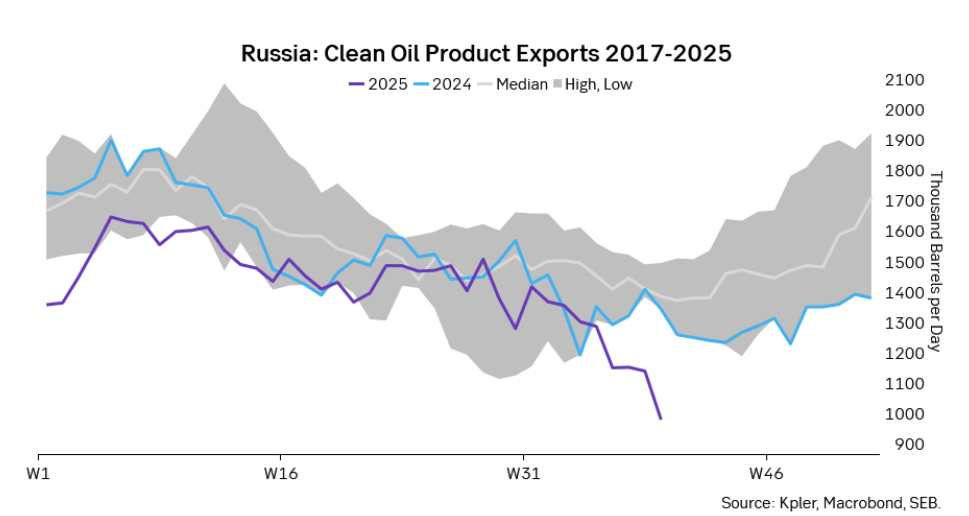
The ICE Gasoil crack and the 3.5% fuel oil crack has been strengthening. The 3.5% crack should have weakened along with rising exports of sour crude from OPEC+, but it hasn’t. Rather it has moved higher instead. The higher cracks could in part be due to the Ukrainian attacks on Russian oil refineries.
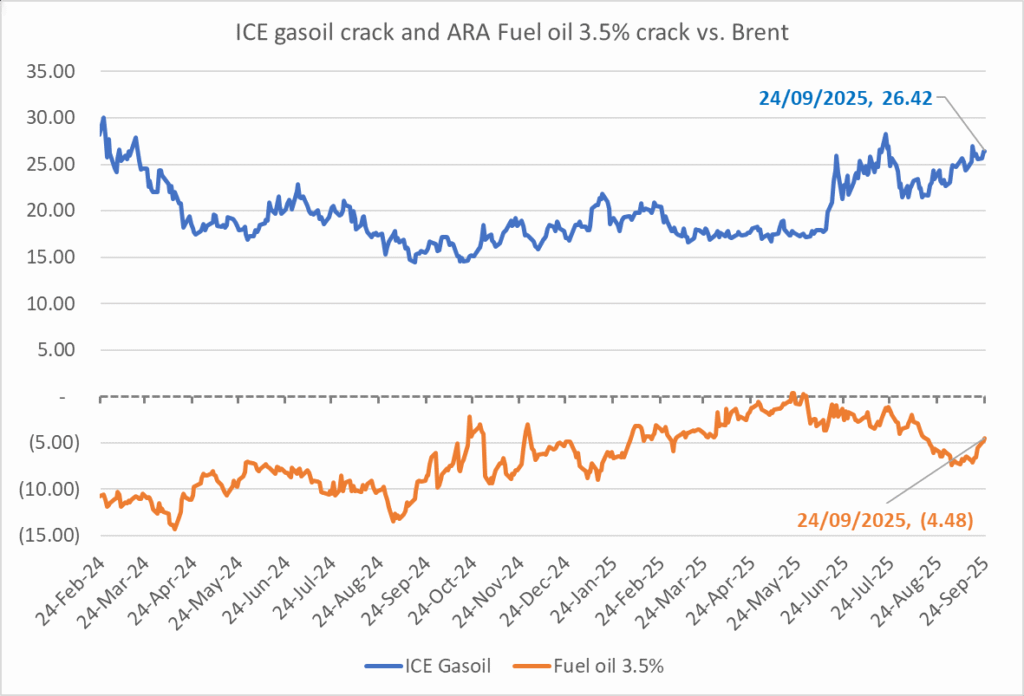
Ukrainian inhabitants graphical representation of Ukrainian attacks on Russian oil refineries on Twitter. Highlighting date of attacks, size of refineries and distance from Ukraine. We have not verified the detailed information. And you cannot derive the amount of outage as a consequence of this.

-

 Nyheter4 veckor sedan
Nyheter4 veckor sedanEurobattery Minerals satsar på kritiska metaller för Europas självförsörjning
-

 Nyheter3 veckor sedan
Nyheter3 veckor sedanMahvie Minerals i en guldtrend
-

 Nyheter4 veckor sedan
Nyheter4 veckor sedanGuldpriset kan närma sig 5000 USD om centralbankens oberoende skadas
-

 Nyheter4 veckor sedan
Nyheter4 veckor sedanOPEC signalerar att de inte bryr sig om oljepriset faller kommande månader
-

 Analys3 veckor sedan
Analys3 veckor sedanVolatile but going nowhere. Brent crude circles USD 66 as market weighs surplus vs risk
-

 Nyheter3 veckor sedan
Nyheter3 veckor sedanAktier i guldbolag laggar priset på guld
-

 Nyheter3 veckor sedan
Nyheter3 veckor sedanKinas elproduktion slog nytt rekord i augusti, vilket även kolkraft gjorde
-

 Nyheter2 veckor sedan
Nyheter2 veckor sedanTyskland har så höga elpriser att företag inte har råd att använda elektricitet



